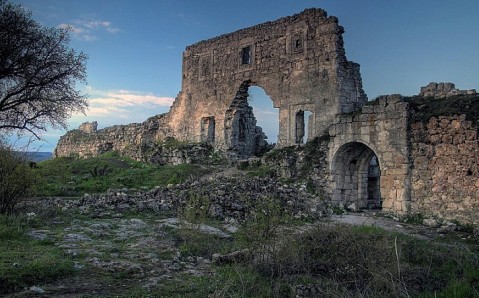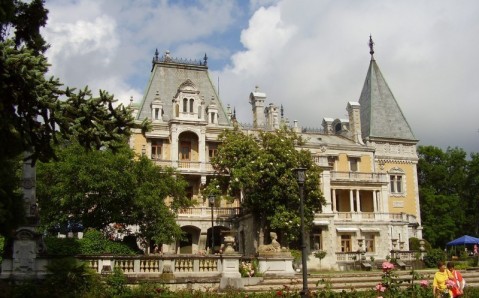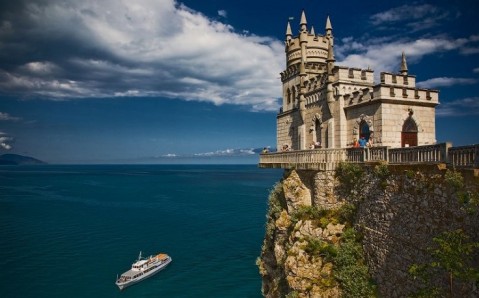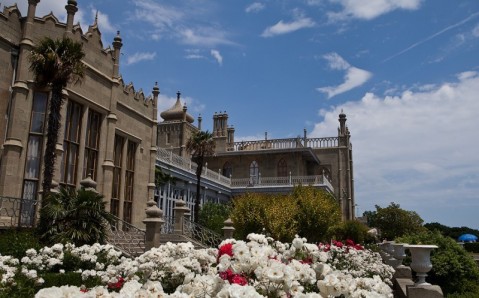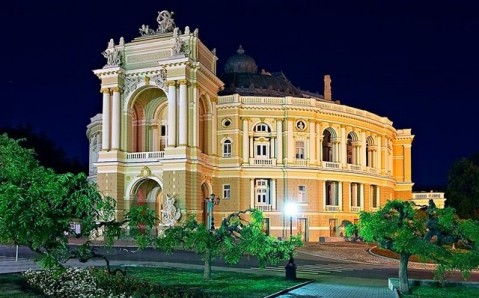Mangup Kale
•
Bakhchysarai
Mangup Kale
•
Bakhchysarai
Mangup Kale is the biggest cavern fortress on the Crimean peninsula. It is located at the top of Mangup Mountain that stands above three picturesque valleys. The plateau, located at the height of almost 600 meters (1,968 feet) above the sea level, has a peculiar form: from above, it looks like a palm with four capes acting as ‘fingers.’ Nature made this area impregnable: on three sides, the platea
Massandra Palace
•
Yalta
Massandra Palace
•
Yalta
This palace is the most elegant and unusual palace on Crimea’s southern coast. Located in a remote picturesque place, surrounded by forest and mountains, the Massandra Palace, with its fanciful architecture, is reminiscent of a fairytale castle.
With its construction beginning in 1881, it was being built for prince Semyon Vorontsov based on the blueprints of a talented architect Etienne Bouchard.
Swallow's Nest
•
Yalta
Swallow's Nest
•
Yalta
The tiny Gothic castle is set, like a swallow’s nest, on the steep Cape of Ai-Todornot cliffs, far from Yalta. It is one of Crimea’s best known trademarks. This elegant building is reminiscent of the castles on the banks of the Rhine, and is considered to be one of the most interesting architectural and historical monuments on the peninsula.
The castle, which at first used to be wooden, got its u
Vorontsov Palace
•
Yalta
Vorontsov Palace
•
Yalta
This architectural monument to Romanticism is one of the shiniest pearls in the necklace that is Crimea. Created by people in tandem with nature, the Vorontsov Palace has amazed guests with its original look for almost two centuries.
The Palace was build in the middle of the 19th century as summer residence of Russian statesman, Prince Mikhail Vorontsov, who was the governor-general of Russia’s s
Livadia Palace
•
Yalta
Livadia Palace
•
Yalta
The white-stone Livadia Palace, which served as a summer residence for Russian emperors in the 19th - 20th centuries, is not just the most beautiful architectural installation of Crimea’s southern coast, but also an important historical monument. Here, Allied leaders defined the fate of the post-WWII world.
The history of the palace began in 1834, when Polish magnate Lev Potockiy bought the tiny
Chersonesus
•
Sevastopol
Chersonesus
•
Sevastopol
This unique monument of antiquity is one of the brightest tourist attractions on the Crimean peninsula. It is recognized as one of Seven Wonders of Ukraine, and it is nominated to be included on UNESCO’s list of World Heritage Sites.
Chersonesus is an ancient city, founded over two and a half thousand years ago by Greek colonists. These ancient inhabitants chose a very favorable place to settle:
Balaklava
•
Sevastopol
Balaklava
•
Sevastopol
Balaklava is a small town near Sevastopol, nestled on the coast of an extremely beautiful bay. This serene harbor, hidden from strangers’ eyes by jagged mountains, is a unique piece of nature. Due to its favorable location it, it sheltered different peoples for thousands of years, and in the post-WWII period, it became a secret base for Soviet submarines. Today, Balaklava, with its amazing landsca
Opera House
•
Odesa
Opera House
•
Odesa
The Odesa National Academic Theater of Opera and Ballet is a real gem of 19th century European architecture, and one of Odesa’s main treasures. This theater, which strikes the eye with its beauty and grandeur, is among the town’s oldest cultural institutions.
Built in the Viennese baroque style and considered to be one of the world’s most wondrous theaters, the opera house is famous not just for
It is one of Odesa’s largest and most important spiritual symbols. Over its tragic history, the temple, which stands on the Cathedral Square, played an important role in the town’s development and its sacral architecture.
The cathedral was founded in 1795 – at the same time as Odesa’s port – and was consecrated in 1808. At first, it was a small religious building, but a hundred years later, it be

